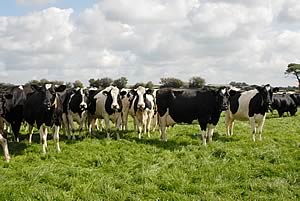11/04/08
Beef and dairy cattle across the country are at risk of sudden
death as a result of a number of unpredictable diseases according
to the Veterinary Laboratories Agency (VLA).
This is the key message that is being conveyed to beef and dairy
farmers who are attending a series of 14 meetings being held at
the VLA’s regional laboratories from Wednesday 9th April
to Thursday 1st May.
The meetings, which are being sponsored by Schering-Plough Animal
Health, will warn farmers of the dangers that infections such as
pneumonia and clostridial disease can bring to livestock and inform
them of the measures necessary to prevent future losses. The importance
of ruling out anthrax as a possible cause will also be emphasised.
Each year approximately 1 in 8 beef or dairy animals die unexpectedly
on farm, with the winter months posing the greatest risk, particularly
to younger cattle and calves. However, sudden deaths can occur
at any time of the year and as such it is essential that farmers
work closely with their local vet and VLA veterinary investigation
officer in order to prevent further loss of life.
David Harwood MRCVS from the VLA laboratory in Winchester explains
that, “Most sudden deaths in cattle are preventable if you
take the appropriate preventative measures. Unfortunately, the
causes of sudden deaths can often be unpredictable and commonly
misunderstood. As such, many sudden deaths are mistakenly blamed
on other causes such as poisoning or lightning strike.
“One of the most common causes of sudden deaths in cattle
and calves is clostridial disease, which is capable of killing
animals quickly and with few warning signs. The organisms which
cause these diseases are widely distributed in the natural environment
and can be found in the gut and tissues of many clinically normal
animals.”
Mr Harwood continues to explain that, “These diseases are
not necessarily brought in by recently purchased animals and could
already be on many farms. They can be difficult to control unless
proper preventative measures are put in place.”
Paul Williams MRCVS, livestock veterinary advisor for Schering-Plough
Animal Health explains that, “There are at least 10 major
clostridial bacteria that can cause sudden deaths in livestock.
For much of the time, the bacteria remain dormant. However, when
trigger factors such as injury, bruising and stress stimulate the
bacteria to multiply, toxins are released in large quantities.
The toxins then attack the muscles, gut and liver, leading to severe
disease and ultimately death.”
Mr Williams continues, “The quick onset of these diseases
means that intensive treatment using antibiotics is rarely effective.
However, protection can be achieved by using a broad-spectrum vaccine
to provide animals with the necessary antibodies to combat all
strains of the lethal toxins. Vaccination is therefore the only
viable control option and is vital for the protection of animals
and profit margins.”
Farmers who want to provide the best possible protection for their
animals are therefore advised to adopt the following safety measures:
- Any mature bovine animal that is found dead should
be investigated as soon as possible;
- Discuss the best course of
action with their local vet, including a post mortem examination
if necessary;
- Good animal management and the use of a broad-spectrum
vaccination can provide effective protection against many of
the common causes of sudden death.
 SAC
Partnership Provides World Class Resources for Livestock Sciences SAC
Partnership Provides World Class Resources for Livestock Sciences
 Avian
Flu: From Pandemic Planning to Vaccine Development Avian
Flu: From Pandemic Planning to Vaccine Development
 RABDF Welcomes Welsh Plans for Badger Cull RABDF Welcomes Welsh Plans for Badger Cull |



